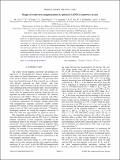| dc.contributor.author | Ciria, M. | |
| dc.contributor.author | Castano, Fernando | |
| dc.contributor.author | Diez-Ferrer, J. L. | |
| dc.contributor.author | Arnaudas, J. I. | |
| dc.contributor.author | Ng, B. G. | |
| dc.contributor.author | O'Handley, Robert C. | |
| dc.contributor.author | Ross, Caroline A. | |
| dc.date.accessioned | 2010-02-24T15:58:54Z | |
| dc.date.available | 2010-02-24T15:58:54Z | |
| dc.date.issued | 2009-09 | |
| dc.date.submitted | 2009-07 | |
| dc.identifier.issn | 1550-235X | |
| dc.identifier.issn | 1098-0121 | |
| dc.identifier.uri | http://hdl.handle.net/1721.1/51808 | |
| dc.description.abstract | The patterning-induced changes in the magnetic anisotropy and hysteresis of epitaxial (100)-oriented Cu/Ni(9, 10, 15 nm)/Cu planar nanowires have been quantified. When the Ni films are patterned into lines, strain relaxation leads to a thickness-dependent net in-plane anisotropy transverse to the lines. The magnetoelastic anisotropy was found from the three-dimensional strain state measured directly by synchrotron x-ray diffraction and has a value of −21 kJ/m[superscript 3] for 10-nm-thick nanowires. The angular dependence of the remanence of the nanowires indicates that the in-plane easy direction is the result of the competition between the cubic magnetocrystalline anisotropy and a uniaxial anisotropy that includes shape and magnetoelastic effects. The patterning-induced changes in magnetoelastic anisotropy, combined with the shape and magnetocrystalline anisotropies, quantitatively explain the net anisotropy of the nanowires. Thus by controlling the film thickness and wire orientation, the easy axis direction of the nanowires may be controlled. | en |
| dc.description.sponsorship | Singapore-MIT Alliance | en |
| dc.description.sponsorship | Fondo Social Europeo | en |
| dc.description.sponsorship | DGA | en |
| dc.description.sponsorship | Spanish MICINN | en |
| dc.language.iso | en_US | |
| dc.publisher | American Physical Society | en |
| dc.relation.isversionof | http://dx.doi.org/10.1103/PhysRevB.80.094417 | en |
| dc.rights | Article is made available in accordance with the publisher's policy and may be subject to US copyright law. Please refer to the publisher's site for terms of use. | en |
| dc.source | APS | en |
| dc.title | Origin of transverse magnetization in epitaxial Cu/Ni/Cu nanowire arrays | en |
| dc.type | Article | en |
| dc.identifier.citation | Ciria, M. et al. “Origin of transverse magnetization in epitaxial Cu/Ni/Cu nanowire arrays.” Physical Review B 80.9 (2009): 094417. © 2009 The American Physical Society. | en |
| dc.contributor.department | Massachusetts Institute of Technology. Department of Materials Science and Engineering | en_US |
| dc.contributor.approver | Ross, Caroline A. | |
| dc.contributor.mitauthor | Castano, Fernando | |
| dc.contributor.mitauthor | Ng, B. G. | |
| dc.contributor.mitauthor | O'Handley, Robert C. | |
| dc.contributor.mitauthor | Ross, Caroline A. | |
| dc.relation.journal | Physical Review B | en |
| dc.eprint.version | Final published version | en |
| dc.type.uri | http://purl.org/eprint/type/JournalArticle | en |
| eprint.status | http://purl.org/eprint/status/PeerReviewed | en |
| eprint.grantNumber | E81 | en |
| eprint.grantNumber | NAN2004-09183-C10-10 | en |
| eprint.grantNumber | PI049/08 | en |
| eprint.grantNumber | MAT2006- 07094 | en |
| dspace.orderedauthors | Ciria, M.; Castaño, F.; Diez-Ferrer, J.; Arnaudas, J.; Ng, B.; O’Handley, R.; Ross, C. | en |
| dc.identifier.orcid | https://orcid.org/0000-0003-2262-1249 | |
| mit.license | PUBLISHER_POLICY | en |
| mit.metadata.status | Complete | |
